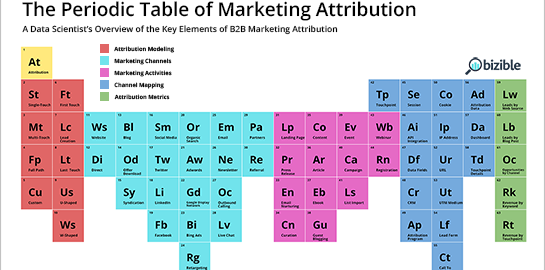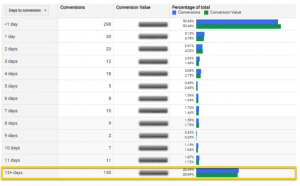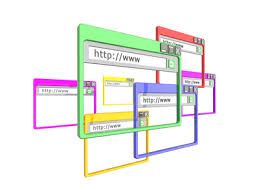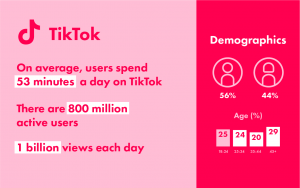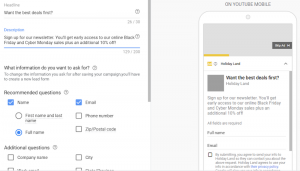As the scientific community recognizes four new elements on the scientific periodic table, it seemed fitting for revenue-focused B2B marketers to join the club with our own chart. The Periodic Table of Marketing Attribution displays the key components necessary for a fully functional, data-driven attribution strategy.
(click to view larger)
While chemists in the scientific community anxiously await the final completion of the seventh row on the periodic chart, data scientists and revenue-focused marketers can show off their exclusive periodic table of 63 elements — signed, sealed, and delivered to you personally by your resident attribution experts.
The following infographic takes each section of elements and explains how they apply to the process of B2B marketing attribution tactics.
(click to view larger)
SECTION #1: ATTRIBUTION MODELING
Attribution is the process of attributing revenue to specific marketing activities that contributed to the conversion of those customers. It can track keywords, campaigns, content, display ads, events (and more) and follow a customer through their interactions with all of those marketing touches. After they become a customer, an attribution model will assign revenue credit to those touches in a specific manner, depending on the model.
Single-touch models only assign credit to one source. Multi-touch models assign revenue credit to multiple touchpoints along the marketing funnel. And, full-path B2B marketing attribution models assign credit to all influential touchpoints from the beginning to the end of a customer’s journey.
SECTION #2: MARKETING CHANNELS
The marketing channels included in the periodic table are those that can specifically be tracked through a B2B marketing attribution program —
- Website
- Direct traffic
- Blog
- Offer download
- Syndication
- Social Media
- Twitter
- Linkedin
- Facebook
- Organic Search
- AdWords
- Google display network
- Bing Ads
- Retargeting
- Email
- Newsletter
- Outbound calling
- Live chat
- Partners
- Referral traffic
All of these sources of leads, opportunities, and customers can be specifically tracked directly to revenue in order to see which channels (or which activities within the channels) are generating the most revenue. B2B marketing attribution strategy is gearing up to be one of the most influential components of a martech stack — because it measures the effectiveness of the entire strategy on a granular level.
SECTION #3: MARKETING ACTIVITIES
The activity elements listed in this portion of the periodic table refer to marketing initiatives that can directly create touchpoints within an attribution program. Each one can serve as a conversion point within the marketing and sales funnel, and each one can be assigned revenue credit in order to gauge how well the respective initiative contributes to the bottom line. From email nurturing and online content, to events and webinars, B2B marketing attribution measures all types of marketing activities, whether they’re online or offline.
SECTION #4: CHANNEL MAPPING
How does an attribution program actually map each touchpoint to its respective channel? How does a conversion point get assigned revenue credit? These elements display the different components used to map touchpoints to their channels and organize them in a way that can be easily sorted through and reported on by a B2B marketer.
The most common ways this is done is through API integrations, cookies, and UTM parameters, which collectively work together to gather tracking data and push that information into the CRM. After that occurs, an attribution program will take it the rest of the way and sort, organize, and process that data into neat dashboards and spiffy reports that allow marketers to easily understand the effectiveness of their marketing.
SECTION #5: ATTRIBUTION METRICS
These elements are a short list of the types of advanced and specialized attribution metrics that a B2B attribution software program can generate. These types of metrics aren’t available through any other type of martech program, because they rely on highly granular and incredibly accurate data. Metrics such as leads by websource, opportunities by channel, and revenue by keyword will help marketers know which channels are making them the most money and how to optimize in order to generate a greater level of ROI.
Digital & Social Articles on Business 2 Community
(282)
Report Post